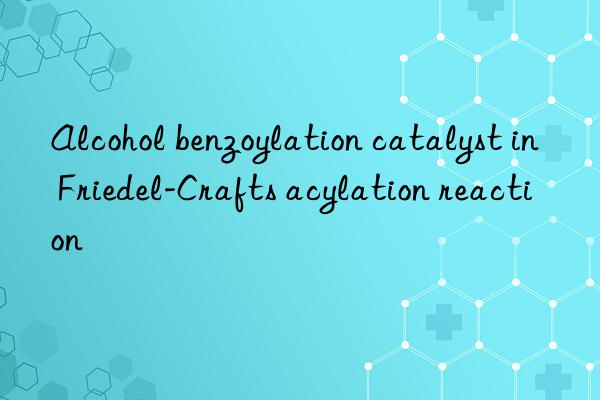
Friedel-Crafts acylation reaction is an important aromatic ring electrophilic substitution reaction in organic chemistry. It introduces acyl groups (RCO -) to synthesize aromatic ketones, esters and other acyl-containing compounds. The Friedel-Crafts acylation reaction usually uses a Lewis acid such as aluminum chloride (AlCl3) as a catalyst, but sometimes benzoylation of alcohols can also be used as part of the Friedel-Crafts acylation reaction, especially when synthesizing specific functionalized aromatic compounds. This article will discuss alcohol benzoylation catalysts in Friedel-Crafts acylation reactions, including reaction mechanisms, catalyst action mechanisms, catalyst selection, and green chemistry considerations.
Friedel-Crafts acylation reaction mechanism and benzoylation of alcohols
The general mechanism of Friedel-Crafts acylation reaction is as follows:
- Activation of acid chloride: Under the action of a catalyst (such as AlCl3), the acid chloride (RCOCl) is activated to form a more powerful electrophile.
- Electrophilic substitution: The activated acyl cation attacks the π electron cloud on the aromatic ring to form a carbocation intermediate.
- Deprotonation and product formation: Subsequently, the intermediate is deprotonated, releasing HCl to form the final acylated product.
In this process, if alcohol is used as one of the reactants, the benzoylation of the alcohol becomes part of the Friedel-Crafts acylation reaction. The benzoylation of alcohols involves the reaction of alcohols with benzoyl chloride or benzoic anhydride in the presence of a catalyst to form the corresponding ester.
Mechanism of action of catalyst
The catalyst plays a vital role in the Friedel-Crafts acylation reaction. It promotes the reaction in the following ways:
- Reducing the activation energy: The catalyst reduces the activation energy of the reaction, making it easier to form acyl cations, thereby accelerating the reaction.
- Improve reaction selectivity: By controlling the reaction pathway, the catalyst can guide the reaction toward the desired product and avoid side reactions.
- Stabilizing intermediates: Catalysts can stabilize intermediates during the reaction, prevent their decomposition, and ensure high yields.
Catalyst selection
Traditional Friedel-Crafts acylation reaction usually uses AlCl3 as a catalyst, but it has some disadvantages, such as difficulty in processing and recycling, and the possibility of producing corrosive by-product HCl. Therefore, finding more environmentally friendly and more effective catalysts has become a research hotspot, such as:
- Heteropolyacid: This type of catalyst has high thermal stability and water stability, and can catalyze Friedel-Crafts acylation reaction under mild conditions.
- Solid acid catalysts: Such as zeolites, montmorillonites, silica-supported metal oxides, etc., which provide the advantages of solid-phase catalysis and facilitate separation and recovery.
- Organic base catalysts: Such as 4-dimethylaminopyridine (DMAP), tetramethylguanidine (TMG), etc. These organic bases can effectively activate the acylation reagent and promote the reaction.
Green chemistry considerations
Green chemistry principles are particularly important when selecting catalysts for Friedel-Crafts acylation, including:
- Catalyst recyclability: Choose reusable catalysts to reduce the generation of chemical waste.
- Use environmentally friendly solvents: Try to use low-toxic, biodegradable solvents, such as water or supercritical carbon dioxide, to reduce the impact on the environment.
- Mild reaction conditions: Use mild reaction conditions, such as photochemical catalysis or electrochemical catalysis, to reduce energy consumption and the formation of by-products.
Conclusion
In the Friedel-Crafts acylation reaction, the benzoylation of alcohols, as one of the steps, can be optimized through careful selection of catalysts. The choice of catalyst not only affects the efficiency of the reaction and the selectivity of the product, but also affects the overall environmental impact of the reaction. Through continuous research and innovation, the development of more efficient and environmentally friendly catalysts, as well as the optimization of reaction conditions, can promote the Friedel-Crafts acylation reaction and related processes in a greener and more sustainable direction. This is not only a demand from the chemical industry, but also a response to global environmental protection responsibilities.
Extended reading:
T120 1185-81-5 di(dodecylthio) dibutyltin – Amine Catalysts (newtopchem.com)
DABCO 1027/foaming retarder – Amine Catalysts (newtopchem.com)
DBU – Amine Catalysts (newtopchem.com)
bismuth neodecanoate – morpholine
amine catalyst Dabco 8154 – BDMAEE
2-ethylhexanoic-acid-potassium-CAS-3164-85-0-Dabco-K-15.pdf (bdmaee.net)



